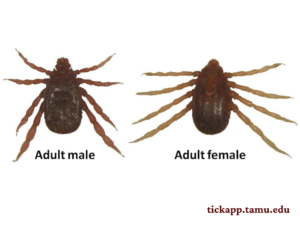
Species: Rhipicephalus (Boophilus) annulatus (Say)
*REGULATORY TICK SPECIES*
Description: This tick exhibits short, compact palps (mouthparts) with lateral ridges and a hexagonally shaped basis capitulum. Color among adults is relatively uniform, typically consisting of shades of brown and an inornate scutum. Adult ticks have eyes and an anal groove is present in front (anterior) of the anus.

Distribution: Originally established throughout 14 southern and southeastern states including Texas, Oklahoma, and parts of southern California, the cattle tick is currently found only in a few counties bordering the Rio Grande River in south Texas due to state and federal tick eradication programs first established in 1906. A permanent quarantine zone extends from Brownsville west and northward to Del Rio, and is monitored by government livestock inspectors in an attempt to prevent livestock and wildlife from re-infesting the US and increasing the risk of bovine babesiosis. The cattle tick remains distributed throughout much of Mexico. Acaricide resistent ticks in Mexico are a significant concern.
Hosts: Cattle are the primary hosts of cattle ticks, however this regulatory tick species is also known to parasitize horses, sheep, goats, wildlife, dogs and cats. The role of native and exotic deer species and other large wildlife ungulates (including free-ranging nilgai antelope) as hosts for maintaining and distributing cattle ticks within and beyond existing quarantine boundaries, are the focus of on-going research in Texas.
Biology: The cattle tick is a one-host species native to the Near East and Mediterranean basin of southern Europe. Introductions of cattle ticks into the US are thought to be linked to cattle importations to settlement regions of the Western Hemisphere by early explorers. The larval-to-adult feeding phase requires 18-20 days to complete. Replete females detach in 21-28 days, and depending on temperature, precipitation, and available vegetation cover, oviposition, incubation, and larval emergence may span one to 9 months in duration. Questing larvae are known to cover the entire bodies of their hosts during periods of heavy infestations, but seem to prefer the usual attachment locations: tail-head, escutcheon, udder/scrotum, dewlap, neck and axillaries. Under favorable climatic conditions and host availability, cattle ticks may produce up to four generations annually.
Associated Disease Pathogens: The cattle tick transmits the haemoprotozoan parasites Babesia bigemina and B. bovis which can cause Texas cattle fever leading to death losses in naïve cattle. These ticks and disease pathogens remain endemic and problematic in regions adjacent to the northern states of Mexico. The cattle tick may also transmit Anaplasma marginale, the bacterial disease agent responsible for anaplasmosis in cattle.
Similar Tick Species: The Southern cattle tick, R. (B.) microplus is also known to infest both wild and domestic hoof-stock within this same region. These two tick species are difficult to differentiate in the field, but adult male R. (B.) annulatus are without the noticeable “tail”, or pointed dorsum present in male R. (B.) microplus.
